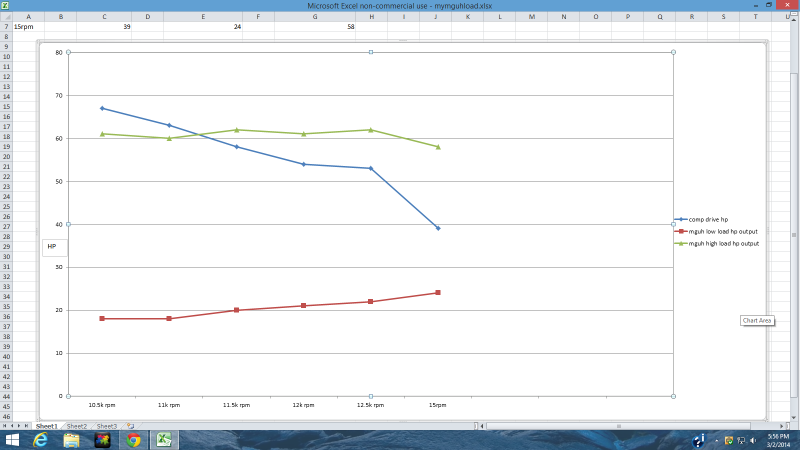- Login or Register
No account yet? Sign up
Sure but ultimately if you take the powerunit as a whole I thought any heat rejected even in the sub-systems was accounted for in the 40% no? That is excluding the 2 MJ per lap coming in from the MGU-K. The only other energy outlet I see is the exhaust gazBlaze1 wrote:Turbo cooling, intercooling, ES cooling, MGU-H cooling, MGU-K cooling etc.PhilS13 wrote:Silly question maybe but I can't find the answer...
2013 V8 @ 30% efficiency and 750 bhp peak power -> 1750 "bhp" of heat generated (waste). Yes only at peak power operation but still.
2014 V6 @ 40% efficiency (self-sustained), 100 kg/hr fuel limit, 46MJ/kg fuel -> 1028 "bhp" of heat generated (waste)
We keep hearing the V6 needs massive cooling relative to last year. Where does that come from ?
They mastered that problem by dumping the gas out the tailpipe. lolWhiteBlue wrote:
Well, we told you all about it as well. Renault simply do not have the know how of the recovery system that Ferrari and Mercedes have. In order to get maximum efficiency you have to utilize the waste gate close to zero. The other manuafcturers have mastered that problem which Renault are still in the process of cracking.
These people are human, they can't play engine gods and study every little thing possible. That's a lot of work you're giving them there. The energy level graph doesn't really change anything. The rate of charge is the current problem. If the technolgy doesn't exist to permit it, then there's nothing that can be done.dren wrote:Renault either underestimated the energy flow into the ES, or the demand of flow out of the ES, or a bit of both. There should never be a situation where the ES is full and there is regeneration going on unless there was some sort of failure. A wastegate should be utilized as a safety only, not as a controller.
There should be an energy level graph for the ES over a lap at each track. It would involve flow in and out from both MGUH and MGUK at each point over the lap. This would be part of the need for PU mapping at each race. Renault must have screwed up somewhere and likely were running really close to the ES limit of storage, hence the need for the resistors. Maybe the battery type and or capacity limit was part of the issue, too. Didn't they say they switched suppliers?
Maybe it is easier to just dump the energy in the quick off throttle stages and only charge the ES on high RPM turbine overrun.

As already answered - a lot of that heat in NA engine went through the exhaust. Additionally, the NA engine cooling liquid has to be kept at about 100°C while intercooler, batteries and electronics have to be cooled to much lower temperatures. The closer the cooled object's temperature is to the ambient the harder it is to exchange the heat with the atmosphere and the radiator has to be bigger.PhilS13 wrote:We keep hearing the V6 needs massive cooling relative to last year. Where does that come from ?
Magnetti Marelli talking about pre-2014 KERS : In terms of cooling, it was possible to make the motor-generator and electronics work up to engine temperature (cooled by the vehicle water circuit, at about 100°).piast9 wrote:As already answered - a lot of that heat in NA engine went through the exhaust. Additionally, the NA engine cooling liquid has to be kept at about 100°C while intercooler, batteries and electronics have to be cooled to much lower temperatures. The closer the cooled object's temperature is to the ambient the harder it is to exchange the heat with the atmosphere and the radiator has to be bigger.PhilS13 wrote:We keep hearing the V6 needs massive cooling relative to last year. Where does that come from ?

Pedal torque demand maps. They can have however many PU maps they want.Shafto wrote:Hello,
I thought I seen somewhere that the teams are required to use a limited amount of engine maps. Is this true or am I imagining things? I was looking at the rules on the F1 site and only engine map related thing I found was they can have one map for each tire they run (soft, hard, inter, wet.)
So, are teams aloud to adjust the maps constantly? Or is it one map for the year?
Sorry if it has been covered in this thread before, but I am not going to read 385 pages!

There is an article on AMuS regarding this matter: http://translate.google.ro/translate?sl ... 89033.htmltechF1LES wrote:Changes Renault have made since Jerez...
Change of battery cell provider
The individual cells that make up the Energy Store have individual over-charge and over-discharge protection. These were proving unreliable due to thermal/vibration issues. Whilst the energy store is sealed in our fitment, I am informed the cells are now supplied by Panasonic.
...
Sure, but remember there is hot exhaust going off the car. In 2013 that carried more of that ~1750hp waste. In 2014 it carries much much less.PhilS13 wrote:Sure but ultimately if you take the powerunit as a whole I thought any heat rejected even in the sub-systems was accounted for in the 40% no? That is excluding the 2 MJ per lap coming in from the MGU-K. The only other energy outlet I see is the exhaust gazBlaze1 wrote:Turbo cooling, intercooling, ES cooling, MGU-H cooling, MGU-K cooling etc.PhilS13 wrote:Silly question maybe but I can't find the answer...
2013 V8 @ 30% efficiency and 750 bhp peak power -> 1750 "bhp" of heat generated (waste). Yes only at peak power operation but still.
2014 V6 @ 40% efficiency (self-sustained), 100 kg/hr fuel limit, 46MJ/kg fuel -> 1028 "bhp" of heat generated (waste)
We keep hearing the V6 needs massive cooling relative to last year. Where does that come from ?
Caterham did 117 laps on Saturday and Toro Rosso managed 81. Lotus did only 33, but they are a week behind everybody else. I don't think all the problems with the Red Bull are down to Renault.ESPImperium wrote:Im hearing wild rumours going about that Red Bull may be courting Cosworth if Renault don't solve the problems quick enough.